Title
Triangle Meshes
- Connectivity / Topology
- Vertices \(\mathcal{V} = \{ v_1, \dots, v_n \}\)
- Edges \(\mathcal{E} = \{ e_1, \dots, e_k \}\), \(e_i \in \mathcal{V} \times \mathcal{V}\)
- Faces \(\mathcal{F} = \{ f_1, \dots, f_m \}\), \(f_i \in \mathcal{V} \times \mathcal{V} \times \mathcal{V}\)
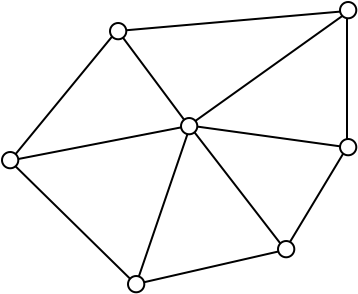
- Geometry
- Vertex positions \(\{ \vec{p}_1, \dots, \vec{p}_n \}\), \(\vec{p}_i \in \R^3\)

Why Triangle Meshes?
- Triangle meshes can represent arbitrary surfaces

Why Triangle Meshes?
- Triangle meshes can represent arbitrary surfaces
- Piecewise linear approximation → error is \(\mathcal{O}(h^2)\)

Why Triangle Meshes?
- Triangle meshes can represent arbitrary surfaces
- Piecewise linear approximation → error is \(\mathcal{O}(h^2)\)
- Approximation error inversely proportional to #triangles

Why Triangle Meshes?
- Triangle meshes can represent arbitrary surfaces
- Piecewise linear approximation → error is \(\mathcal{O}(h^2)\)
- Approximation error inversely proportional to #triangles
- Adaptive tesselation can adapt to surface curvature


Why Triangle Meshes?
- Triangle meshes can represent arbitrary surfaces
- Piecewise linear approximation → error is \(\mathcal{O}(h^2)\)
- Approximation error inversely proportional to #triangles
- Adaptive tesselation can adapt to surface curvature
- Simple primitives can be processed efficiently by CPU/GPU

Mathematical Manifold Definition
A topological space \(M\) is a topological \(n\)-manifold if:

For manifold with boundaries replace \(\mathbb{R}^n\) with \(\mathbb{H}^n\).
Two-Manifold Surfaces
- Local neighborhoods are disk-shaped
- Guarantees meaningful neighborhood enumeration
- Required by most algorithms
- Non-manifold examples:

Mesh Data Structures
2D Mesh Combinatorics: Euler’s Polyhedron Formula
\[V - E + F = \chi = 2-2g-n\]
- \(g\) denotes the number of “handles”
- \(n\) denotes the number of boundaries
- \(\chi \approx 0\) relative to \(V,E,F\) for the vast majority of meshes
\[ 2E \approx 3F \approx 6V \] (first relation is equality if there are no boundaries)
Face Set
- Face Set is a standard file format for triangle meshes (e.g. STL format)
- Memory consumption
36 B/f = 72 B/v
Indexed Face Set
- Indexed Face Sets are used for many file formats (e.g. OFF, OBJ, VRML)
- Memory consumption
12 B/v + 12 B/f = 36 B/v
Face-Based Connectivity
- Store connectivity per face
- Memory consumption
16 B/v + 24 B/f = 64 B/v - Non-constant element size for general polygonal meshes
- Edges not represented
Edge-Based Connectivity
- Store connectivity per edge
- Memory consumption
16 B/v + 4 B/f + 32 B/e = 120 B/v - Edges explicitly represented
- Missing edge orientation leads to case distinctions during traversal
Halfedge-Based Connectivity
- Store connectivity per halfedge
- Memory consumption
16 B/v + 4 B/f + 20 B/h = 144 B/v
(can be reduced to 96 B/v) - Edges & halfedges explicitly represented
- No case distinctions during traversal!
One-Ring Traversal
- Simple one-ring traversal without case distinctions:
- Start at vertex
- Outgoing halfedge
- Opposite halfedge
- Next halfedge
- Opposite halfedge
- Next halfedge
- …
Half-Edge navigation demo
Halfedge-Based Libraries
- CGAL
- http://www.cgal.org
- Computational geometry
- OpenMesh
- http://www.openmesh.org -Mesh processing
- Surface_mesh
- http://graphics.uni-bielefeld.de/publications/imr11/
- Like OpenMesh, but without templates
Triangle Meshes
- Connectivity / Topology
- Vertices \(\mathcal{V} = \{ v_1, \dots, v_n \}\)
- Edges \(\mathcal{E} = \{ e_1, \dots, e_k \}\), \(e_i \in \mathcal{V} \times \mathcal{V}\)
- Faces \(\mathcal{F} = \{ f_1, \dots, f_m \}\), \(f_i \in \mathcal{V} \times \mathcal{V} \times \mathcal{V}\)

- Geometry
- Vertex positions \(\{ \vec{p}_1, \dots, \vec{p}_n \}\), \(\vec{p}_i \in \R^3\)

Normal Vectors
- Triangle normal \[ \vec{n}(T) = \frac{\left(\vec{b}-\vec{a}\right) \times \left(\vec{c}-\vec{a}\right)} {\norm{\left(\vec{b}-\vec{a}\right) \times \left(\vec{c}-\vec{a}\right)}} \]
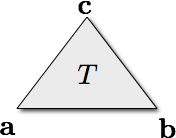
- Vertex normal
- Average of incident triangles’ normals \(\vec{n}(T_i)\)
- Weighted by area or opening angle \(w(T_i)\)

Vertex Normals



Discrete Curvatures
- How to discretize curvatures on a mesh?
- Zero curvature within triangles
- Infinite curvature at edges / vertices
- Point-wise definition does not make sense
- Approximate differential properties at point \(\vec{x}\) as average over local neighborhood \(A(\vec{x})\)
- \(\vec{x}\) is a mesh vertex
- \(A(\vec{x})\) is within one-ring neighborhood
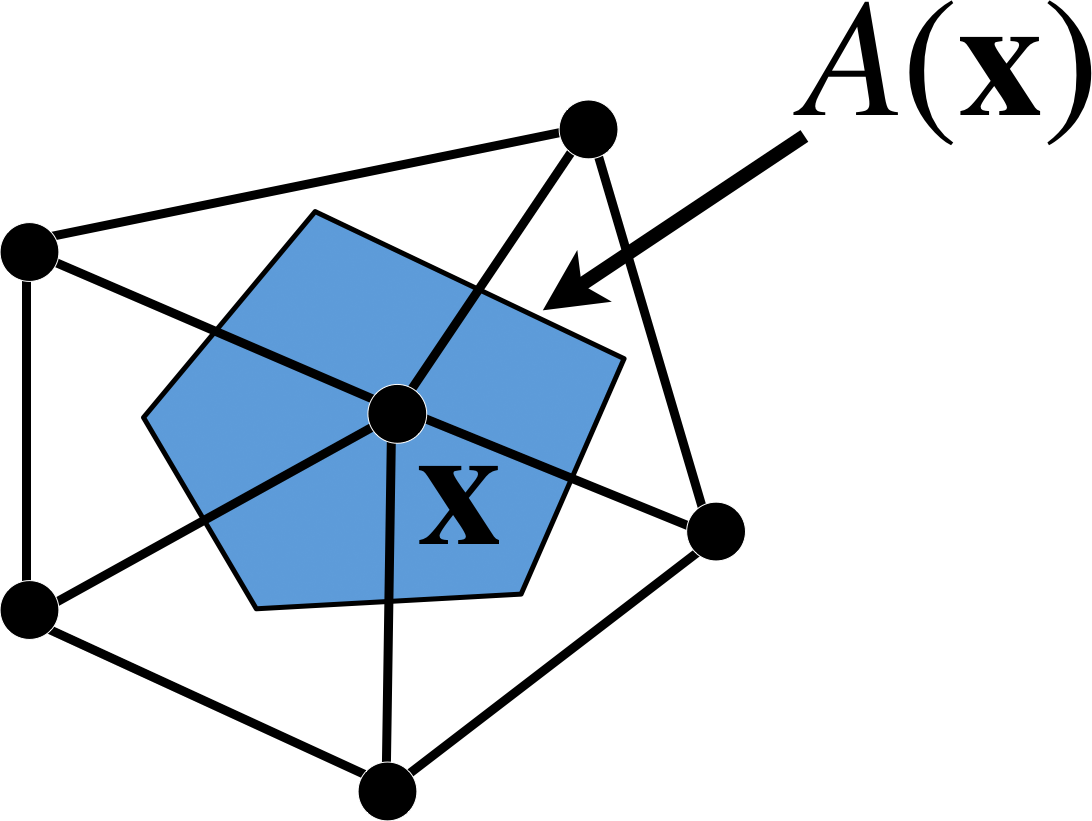
Discrete Curvatures
- How to discretize curvatures on a mesh?
- Zero curvature within triangles
- Infinite curvature at edges / vertices
- Point-wise definition does not make sense
- Approximate differential properties at vertex \(v\) as average over local neighborhood \(A(v)\) \[C\of{v} \;\approx\; \frac{1}{A\of{v}} \int_{A\of{v}} C\of{\vec{x}} \func{d}A\]

Barycentric Cells
- For each triangle of one-ring, connect vertex with edge midpoints and triangle barycenters

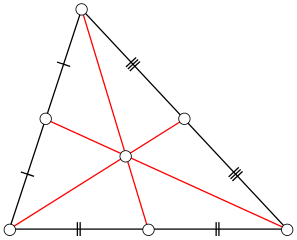
- Simple to compute: Area is 1/3 of triangle areas
- How to compute triangle areas?
3D Cross Product
- Given two 3D vectors \(\vec{a}\) and \(\vec{b}\), computes a vector \(\vec{c}\) that is orthogonal to them \[ \vec{c} \;=\; \vec{a} \times \vec{b} \;=\; {\tiny \matrix{ a_2 b_3 - a_3 b_2 \\ a_3 b_1 - a_1 b_3 \\ a_1 b_2 - a_2 b_1 }} \]

- Measures the area of parallelogram spanned by vectors \(\vec{a}\) and \(\vec{b}\) \[ \norm{\vec{a} \times \vec{b}} = \norm{\vec{a}} \cdot \norm{\vec{b}} \cdot \sin\theta \]

- Measures volume spanned by vectors \(\vec{a}\), \(\vec{b}\), \(\vec{c}\) \[ \mathrm{vol}\of{\vec{a}, \vec{b}, \vec{c}} \;=\; \abs{ \vec{a} \, \vec{b} \, \vec{c} } \;=\; \trans{\left( \vec{a} \times \vec{b} \right)} \vec{c} \]
Wikipedia: Cross Product
Voronoi Cells
- For each triangle of one-ring, connect vertex with edge midpoints and triangle circumcenter


- How to compute circumcircles? Intersection of perpendicular bisectors.
Barycentric vs. Voronoi Cells
Voronoi cells provide better approximation than barycentric cells, but are more complex to compute
![]()
barycentric ![]()
voronoi ![]()
comparison ![]()
comparison
- Problem: Circumcenter can lie outside of triangle
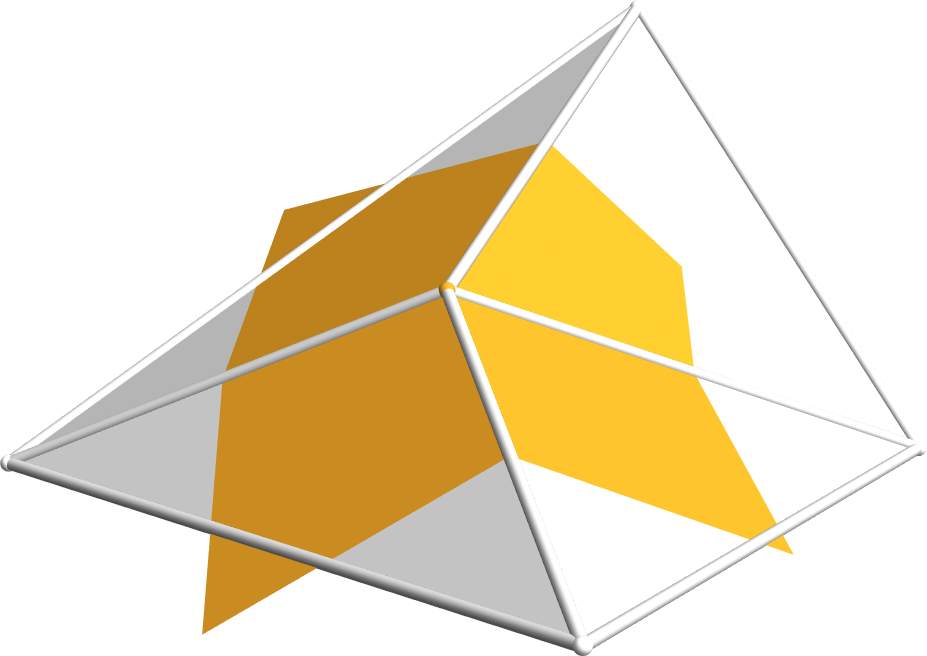

Mixed Cells
- For each triangle of one-ring, connect vertex with edge midpoints and …
- … circumcenters for non-obtuse triangles
- … midpoints of opposite edge for obtuse triangles



- See Meyer et al. 2003 for computational details.
Discrete Curvatures
- How to discretize all the differential operators to triangle meshes?
- First derivative: gradients, tangents, normal
- Second derivative: Min, Max, Mean, and Gauss curvature
- We do not want to directly discretize the second fundamental form, since second derivatives are hard to approximate for triangle meshes.
Discrete Curvatures
Compute Gaussian curvature \(K\):
-by discretizing Gauss-Bonnet Theorem
Compute mean curvature \(H\):
-by discretizing Laplace-Beltrami operator
Compute min and max curvatures:
-from \(H\) and \(K\) we can compute \(\kappa_1\) and \(\kappa_2\)
Gauss-Bonnet Theorem
Integral of Gaussian curvature over a surface \(\Omega\) and the geodesic curvature on its boundary \(\partial \Omega\) is a topological invariant
\[ \int_\Omega K \, dA + \int_{\partial \Omega} k_g \, ds = 2 \pi \, \chi(\Omega) \]For \(\Omega\) with disk topology \(\chi(\Omega)=1\) and
\[ \int_\Omega K \, dA = 2 \pi - \int_{\partial \Omega} k_g \, ds\]
Wikipedia: Gauss-Bonnet Theorem
Discrete Gauss Curvature
- Compute Gauss curvature by Gauss-Bonnet theorem and averaging \[ K(v) \approx \frac{1}{| A(v) |} \int_{A(v)} K \, dA = \frac{1}{| A(v) |} \left( 2 \pi - \sum_j \theta_{j} \right)\]
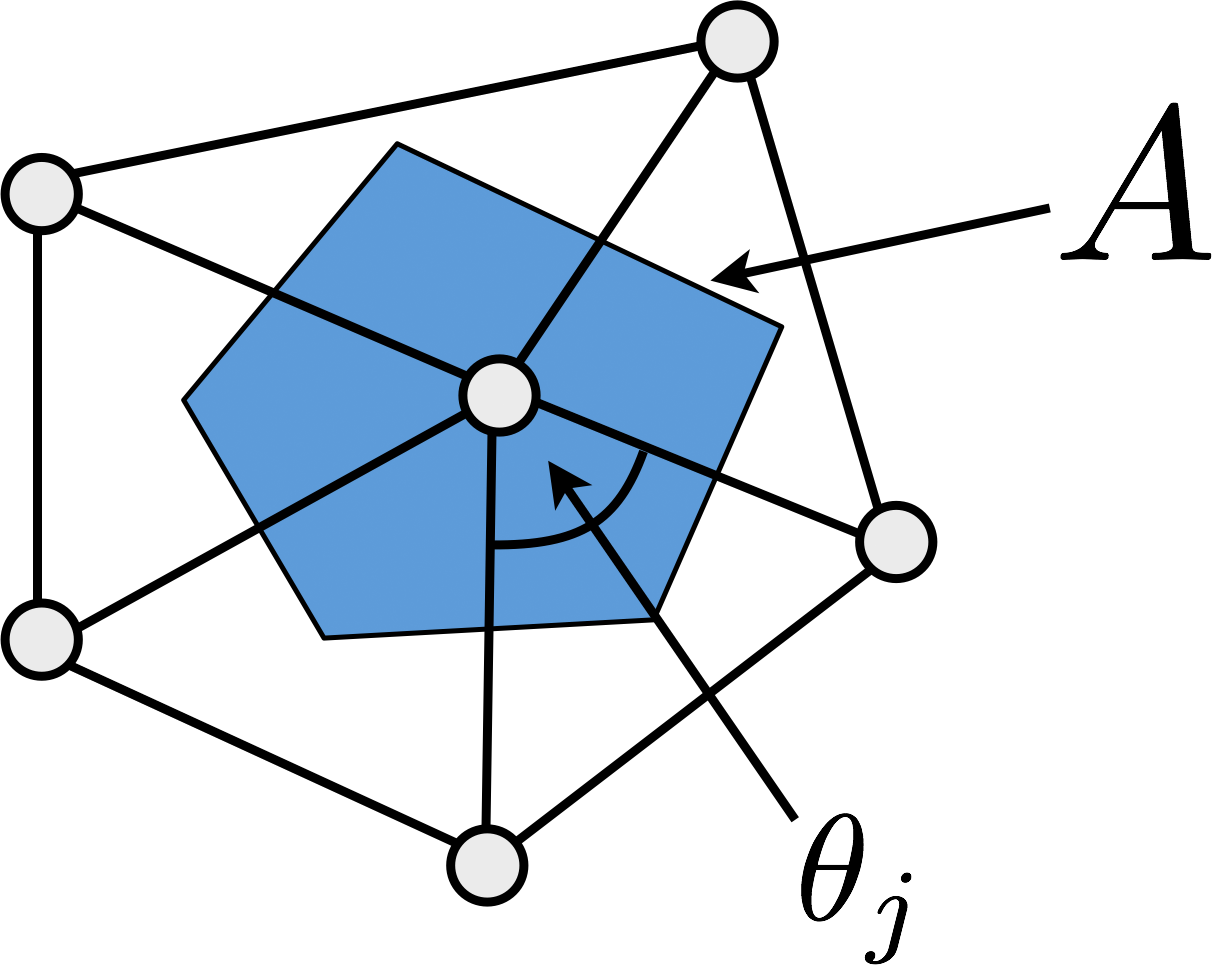

Discrete Gauss Curvature
Discrete Curvatures
Compute Gaussian curvature \(K\):
-by discretizing Gauss-Bonnet Theorem
Compute mean curvature \(H\):
-by discretizing Laplace-Beltrami operator
Compute min and max curvatures:
-from \(H\) and \(K\) we can compute \(\kappa_1\) and \(\kappa_2\)
Laplace Operator on Meshes?
- Extend finite differences to meshes? Which weights to choose per vertex / edge?



Uniform Laplace
- Uniform Laplace-Beltrami discretization \[ \laplace_\func{uni} f\of{v_i} \;:=\; \frac{1}{\abs{\set{N}_1\of{v_i}}} \sum_{v_j \in \set{N}_1\of{v_i}} \left( f\of{v_j} - f\of{v_i} \right) \]
- Properties
- simple and efficient
- depends only on connectivity
- does not take into account geometry at all

Uniform Laplace
- Uniform Laplace-Beltrami discretization \[ \laplace_\func{uni} \vec{x}_i \;:=\; \frac{1}{\abs{\set{N}_1\of{v_i}}} \sum_{v_j \in \set{N}_1\of{v_i}} \left( \vec{x}_j - \vec{x}_i \right) \;\approx\; -2 H \vec{n} \]
- Properties
- simple and efficient
- bad approximation for irregular triangulations, e.g. can give non-zero \(H\) for planar meshes
- does not take into account scale

Divergence Theorem & Laplace
- Divergence Theorem \[ \int_{A_i} \func{div} \, \vec{F} ( \vec{u} ) \mathrm{d}A = \int_{\partial A_i} \vec{F}(\vec{u}) \cdot \vec{n}(\vec{u}) \mathrm{d}s \]
- Laplace operator \[ \int_{A_i} \Delta f(\vec{u}) \,\mathrm{d}A \;=\; \int_{A_i} \func{div} \grad f(\vec{u}) \,\mathrm{d}A \;=\; \int_{\partial A_i} \grad f(\vec{u}) \cdot \vec{n}(\vec{u}) \,\mathrm{d}s \]
Wikipedia: Divergence Theorem , Laplace Operator
Functions on a Mesh
- Given per-vertex values \(f(v_i) = f(\vec{x}_i) = f(\vec{u}_i) = f_i\) we obtain a piecewise linear function per triangle \[f(\vec{u}) \;=\; f_i B_i (\vec{u}) + f_j B_j(\vec{u}) + f_k B_k(\vec{u})\]
- We use linear basis functions \(B_i\), \(B_j\), \(B_k\) on a triangle
![basisFunctions.png]()
Gradients on a Mesh
- The gradient of function \(f\) on triangle \((v_i, v_j, v_k)\) is \[ \grad f(\vec{u}) \;=\; f_i \grad B_i(\vec{u}) + f_j \grad B_j(\vec{u}) + f_k \grad B_k(\vec{u}) \]
- Since \(B_i + B_j + B_k = 1\) we have \[ \grad B_i + \grad B_j + \grad B_k = 0 \]
- Combining the two equations gives \[ \grad f(\vec{u}) \;=\; \left( f_j - f_i \right) \grad B_j(\vec{u}) + \left( f_k - f_i \right) \grad B_k(\vec{u}) \]
Gradients on a Mesh
- The gradient of the linear basis functions \(B_i\), \(B_j\), \(B_k\) is \[ \grad B_i (\vec{u}) \;=\;
\frac{ \left( \vec{x}_k - \vec{x}_j \right)^{\perp} }{ 2 \, A_T }
\,,\quad
\grad B_j (\vec{u}) \;=\;
\frac{ \left( \vec{x}_i - \vec{x}_k \right)^{\perp} }{ 2 \, A_T }
\,,\quad
\grad B_k (\vec{u}) \;=\;
\frac{ \left( \vec{x}_j - \vec{x}_i \right)^{\perp} }{ 2 \, A_T }
\]
![basisFunctions.png]()
- Combining with equations from previous slide we get \[ \grad f(\vec{u}) \;=\; \left( f_j - f_i \right) \frac{ \left( \vec{x}_i - \vec{x}_k \right)^{\perp} }{ 2 \, A_T } + \left( f_k - f_i \right) \frac{ \left( \vec{x}_j - \vec{x}_i \right)^{\perp} }{ 2 \, A_T } \]
Divergence Theorem & Laplace
- Laplace operator \[ \int_{A_i} \Delta f(\vec{u}) \,\mathrm{d}A \;=\; \int_{\partial A_i} \grad f(\vec{u}) \cdot \vec{n}(\vec{u}) \,\mathrm{d}s \]

- Per triangle segment \[ \begin{align} \int_{\partial A_i \cap T} \grad f(\vec{u}) \cdot \vec{n}(\vec{u}) \mathrm{d}s & \;=\; \grad f(\vec{u}) \cdot (\vec{a} - \vec{b})^{\perp} \\ & \;=\; \frac{1}{2} \grad f(\vec{u}) \cdot (\vec{x}_j - \vec{x}_k)^{\perp} \end{align} \]

Discrete Laplace-Beltrami
\[ \begin{align*} \int_{\partial A_i \cap T} \grad f(\vec{u}) \cdot \vec{n}(\vec{u}) \mathrm{d}s & \;=\; \frac{1}{2} \grad f(\vec{u}) \cdot (\vec{x}_j - \vec{x}_k)^{\perp} \\ & \;=\; \begin{split}\left(f_j-f_i \right) \frac{\left(\vec{x}_i-\vec{x}_k \right)^{\perp} \cdot \left(\vec{x}_j-\vec{x}_k \right)^{\perp}}{4 A_T} \\ \;+\; \left(f_k-f_i \right) \frac{\left(\vec{x}_j-\vec{x}_i \right)^{\perp} \cdot \left(\vec{x}_j-\vec{x}_k \right)^{\perp}}{4 A_T}\end{split}\\ & \;\;\vdots\; \\ & \;=\; \frac{1}{2} \cot \gamma_k \left(f_j - f_i \right) \;+\; \frac{1}{2} \cot \gamma_j \left(f_k - f_i \right) \end{align*} \]


Discrete Laplace-Beltrami
- Cotangent discretization \[ \laplace_{\set{S}} f\of{v_i} \;:=\; \frac{1}{2A\of{v_i}} \sum_{v_j \in \set{N}_1\of{v_i}} \left( \cot \alpha_{ij} + \cot \beta_{ij} \right) \left( f\of{v_j} - f\of{v_i} \right)\]

For a full derivation see Chapter 3.3.4 of PMP book
Discrete Laplace-Beltrami
Cotangent discretization
\[ \laplace_{\set{S}} f\of{v_i} \;:=\; \frac{1}{2A\of{v_i}} \sum_{v_j \in \set{N}_1\of{v_i}} \left( \cot \alpha_{ij} + \cot \beta_{ij} \right) \left( f\of{v_j} - f\of{v_i} \right)\]Problems
- how to compute cotan?
- weights can become negative (when?)
- depends on triangulation
Still the most widely used discretization
Discrete Curvatures
Compute Gaussian curvature \(K\):
-by discretizing Gauss-Bonnet Theorem
Compute mean curvature \(H\):
-by discretizing Laplace-Beltrami operator
Compute min and max curvatures:
-from \(H\) and \(K\) we can compute \(\kappa_1\) and \(\kappa_2\)
Discrete Curvatures
- Mean curvature (absolute value) \[ H(v_i) = \frac{1}{2} \norm{ \laplace_\set{S} \vec{x}_i}\]
- Gaussian curvature \[ K(v_i) = (2 \pi - \sum_j \theta_{j}) \,/\, A(v_i) \]
- Principal curvatures \[ \begin{eqnarray} \kappa_1(v_i) &=& H(v_i) + \sqrt {H(v_i)^2 - K(v_i)} \\ \kappa_2(v_i) &=& H(v_i) - \sqrt {H(v_i)^2 - K(v_i)} \end{eqnarray} \]
Discrete Mean & Principal Curvatures
Outlook
- In the following lectures, the Laplacian will also be used to
- improve mesh quality
- compute a parameterization
- deform a surface
- etc.
The Laplacian is the central concept in this course!
Literature
- Botsch et al., Polygon Mesh Processing, AK Peters, 2010
- Chapter 3



